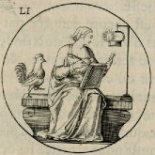In effigiem Caroli Patin
Claude Lefebvre (1632-1675) was his generation’s leading portrait painter, perhaps best known today for the portrait of Jean-Baptiste Colbert that he presented as his reception piece to the Académie. Lefebvre was also a printmaker, but his work in this medium consists of just four portraits: those of his mother (no impressions known), of himself, of the print dealer Alexandre Boudan, and of the physician and numismatist Charles Patin (1633-1693). The latter was produced for Patin’s 1663 folio edition of Fulvio Orsini’s Familiae Romanae in Antiquis Numismatibus; in the same year, Lefebvre reworked his plate for inclusion in Patin’s treatise on peat and its use as fuel.
Modern print scholars appreciate especially Lefebvre’s portrait of Boudan, a freely and vividly etched image which shows the influence of Van Dyck. In comparison, the more formal portrait of Patin appears “rather conventionally executed”1 – a conventionality surely dictated by its function as a frontispiece. But Lefebvre’s work also calls for another comparison, namely with the portrait of Patin engraved in 1667 by Antoine Masson, one of the most virtuosic and original printmakers of the seventeenth century.
Charles’ father Guy, a prominent physician and prolific letter-writer, praised the “excellence” of Masson’s burin:
J’ai céans des portraits de mon Carolus en taille-douce pour vous envoyer. Ils sont très bien faits, on lui en demande de toutes parts, tant à cause de lui, qu’on aime, qu’à cause de celui qui l’a gravé, qui est excellent en son art, nommé Masson.2
Like Lefebvre’s portrait, Masson’s is accompanied by a Latin quatrain composed by the preacher and writer François Ogier, a friend of the Patin family. In 1671 it was used to adorn another numismatic folio authored by Charles Patin, Imperatorum Romanorum Numismata.
In the meantime, however, Patin had already fled France, just before being condemned to the galleys for trafficking in counterfeit and forbidden books.3 After several years of travels throughout Europe, he settled in Padua where he was appointed to a chair of medicine and continued to write (and trade) books. In 1682, he published Lyceum Patavinum, containing his and his fellow professors’ biographies along with their portraits by Martial Desbois. A fourth and, it seems, final portrait shows Charles Patin surrounded by his wife and two daughters, all of whom were published authors in their own right and members of the Accademia dei Ricovrati.4
Volker Schröder
February 9, 2017
Footnotes
1. Sue Welsh Reed, French Prints from the Age of the Musketeers (Boston: Museum of Fine Arts, 1998), p. 251; see also Véronique Meyer in Visages du Grand Siècle (Paris: Somogy, 1997), p. 272.
2. Letter to André Falconet, February 4, 1667, Correspondance française de Guy Patin, ed. Loïc Capron, Paris: Bibliothèque interuniversitaire de santé, 2015. – In 1670, Antoine Masson also engraved a striking portrait of Guy Patin.
3. Françoise Waquet, “Guy et Charles Patin, père et fils, et la contrebande du livre à Paris au XVIIe siècle,” Journal des savants, 1979, p. 125-148. See also Ella Hassett, “Charles Patin: Coins and Condemnation”, online exhibition, Edward Worth Library, Dublin, 2015.
4. See Nicola Shilliam, “Charlotte Catherine Patin: A Seventeenth-Century Female Art Historian?”, Marquand Library of Art and Archaeology, Princeton University, 2015.





